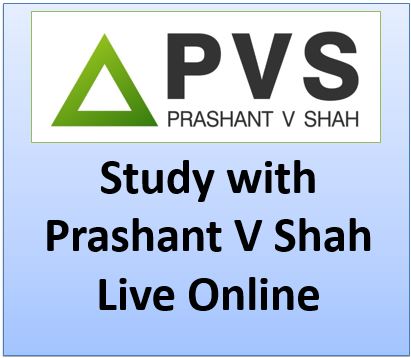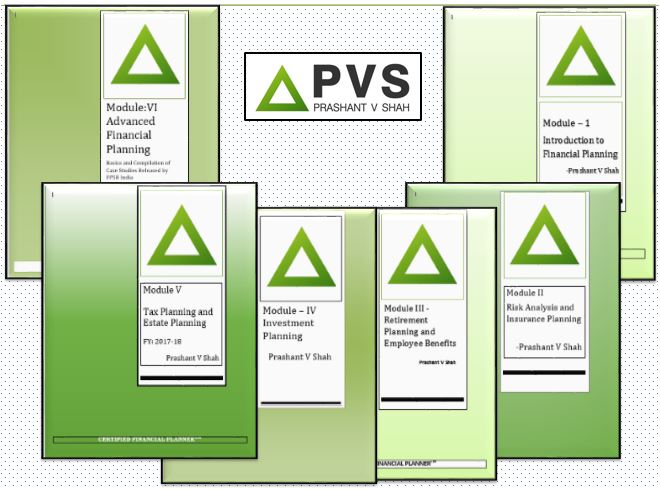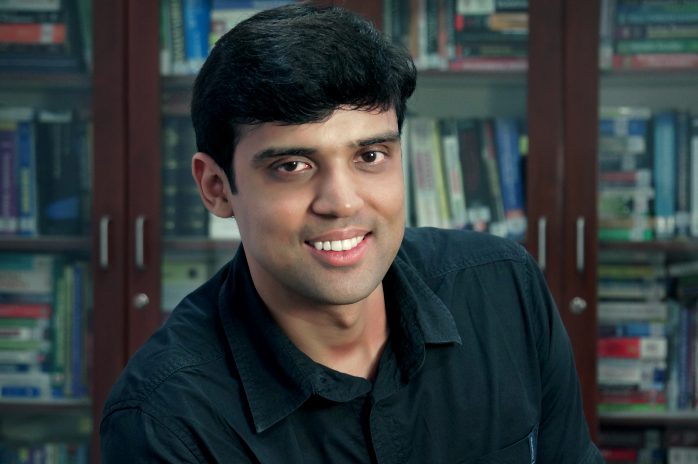Important Questions for CFP – Retirement Planning
Posted by Prashant Shah on July 24, 2017
Your client starts investing for his retirement goal starting at age 45 years. On 55, todays, he has accumulated 35 Lakh, which he finds insufficient on maturing age 60 if he withdraws 5 lakh p.a. inflation adjustment from his accumulated corpus for 30 years post retirement if the corpus is invested at 7.5% p.a. with inflation expectation of 5.5% p.a. If prior to retirement the growth rate of 9.5% is considered for investing already accumulation fund and fresh annual investment of 3.5 lakh. You estimate the period of delayed retirement beyond.
- 4 years 4 month
- 3 years
- 6 years 6 month
- 4 years
A buys second house at 60 lakh. Available loan is 40 lakh for 15 year at 9.5% rate. He liquidates his portfolio towards down payment stamp duty and furnishings. He has 5 lakh cash in hand at present. He is expected to save annually save 2 lakh. He would rent out new house at a rent of 25000 p.m. He will invest remaining cash in hand along with quarterly saving and rent received net of 20% maintenance charge on a quarterly basis beginning a quarter from now. Considering 8% p.a. growth in investment and real estate prices. What would be his net worth five years from now?
- 90 L
- 82 L
- 93 L
- 107 L
A professional just retired has accumulated Rs. 52 lakh. He invests this corpus in an investment instrument giving return of 8% p.a. His current annual household expenses are Rs. 6.6 lakh, escalating at inflation of 6% p.a. He would rent out his other fixed property at an expected annual rent of Rs. 2.40 lakh, the rentals increasing at 6% p.a. The balance expenses are met by withdrawing from the invested corpus. The commercial property, currently valued at Rs. 60 lakh, is expected to appreciate at 8% p.a. He expects to sell the property after 15 years to create a fresh corpus for his living expenses. How long the total funds available are expected to last after 15 years?
- 14 years 11 month
- 14 years 4 month
- 12 years 7 month
- 13 years 2 month











A said
Your client starts investing for his retirement goal starting at age 45 years. On 55, todays, he has accumulated 35 Lakh, which he finds insufficient on maturing age 60 if he withdraws 5 lakh p.a. inflation adjustment from his accumulated corpus for 30 years post retirement if the corpus is invested at 7.5% p.a. with inflation expectation of 5.5% p.a. If prior to retirement the growth rate of 9.5% is considered for investing already accumulation fund and fresh annual investment of 3.5 lakh. You estimate the period of delayed retirement beyond.
Hi! please can you show the solution to this question I’m getting the answer to be 6 years.
Prashant Shah said
Lets first find the corpus
PMT = 500000
N=30
I/Y = REAL RATE
PV = 11575813
FIND PERIOD
FV = 11575813
PV = 3500000
PMT = 350000
I/Y = 9.5
N = ? APPROX 8
As he has 5 more years to retirement, the period of delay is 3 years.
Regards.
A said
Thank you!
M.Nandagopal said
A buys second house at 60 lakh. Available loan is 40 lakh for 15 year at 9.5% rate. He liquidates his portfolio towards down payment stamp duty and furnishings. He has 5 lakh cash in hand at present. He is expected to save annually save 2 lakh. He would rent out new house at a rent of 25000 p.m. He will invest remaining cash in hand along with quarterly saving and rent received net of 20% maintenance charge on a quarterly basis beginning a quarter from now. Considering 8% p.a. growth in investment and real estate prices. What would be his net worth five years from now?
90 L
82 L
93 L
107 L
Dear sir,
Please provide detailed solution to the above problem
VISH said
lets first take investment part ,
n=5*4
i=8%
pv= 5lakh
pmt= 50k from annual savings + 60k from rent = 1.1lakh
fv will come 3443792
outstanding loan after 5 yrs = 3227958
value of house after 5 yrs = 8815968
net worth after 5 yrs = (8815968+3443792)-3227958= 9031802 ( approx 90 lakh)
Pandurana said
While the answer of Approx 90 L is correct, i think the set should be ‘0’ instead of ‘1’ as the question states ‘on a quarterly basis beginning a quarter from now’ which is essentially end of quarter and not beginning of quarter
lets first take investment part ,
n=5*4
i=8%
pv= 5lakh
pmt= 50k from annual savings + 60k from rent = 1.1lakh
fv will come 33,92166.10
Soyeb Ali Mullick said
A professional just retired has accumulated Rs. 52 lakh. He invests this corpus in an investment instrument giving return of 8% p.a. His current annual household expenses are Rs. 6.6 lakh, escalating at inflation of 6% p.a. He would rent out his other fixed property at an expected annual rent of Rs. 2.40 lakh, the rentals increasing at 6% p.a. The balance expenses are met by withdrawing from the invested corpus. The commercial property, currently valued at Rs. 60 lakh, is expected to appreciate at 8% p.a. He expects to sell the property after 15 years to create a fresh corpus for his living expenses. How long the total funds available are expected to last after 15 years?
14 years 11 month
14 years 4 month
12 years 7 month
13 years 2 month
Dear sir please provide the solution of above question.
lakshay gupta said
RRR =2/1.06
PV1(RRR%;15;660000/1.06;0;0)
PV2(RRR%;15;240000/1.06;0;0)
PV1-PV2 = 5134603
5200000-5134603= 65396
FV1(0.08;15;0;-65396;1)
FV2(0.08;15;0;-6000000;1)
FV1+FV2 = 19240464
FV(0.06;15;0;-660000;0) = 1581728
=NPER(RRR%;1581728;-19240464;0;1)
=13.6
shekar said
A client has 600000 as salary per year and he starts planning for retirement. He saves 10% of his annual salary in a fund, which would yield 8.5% p.a. He would set aside 2% of his salary every year to take strategic advantage and expects a return of 12% pa and the money from such fund is redeemed and invested in the retirement portfolio every 5 years. What is he expected to retire with 15 years from today
pls explain the calculation
Jasbir Singh said
Salary 600000
Savings 60000
Extra Savings 12000
1st 5 Year
PMT 60000 12000
Nper 5 5
Rate 8.50% 12%
FV ₹ 385,741.77 ₹ 85,382.27
Normal Savings Extra-Savings
2nd 5 Years
PV=385741.77 + 85382.27=471124.04
PV ₹ 471,124.04
PMT 60000 12000
Nper 5 5
Rate 8.50% 12%
FV £1,094,150.58 ₹ 85,382.27
Normal Savings Extra-Savings
3rd 5 Years
PV=1094150.58+85382.27
PV ₹ 1,179,532.85
PMT 60000 12000
Nper 5 5
Rate 8.50% 12%
FV ₹ 2,159,354.24 ₹ 85,382.27
Normal Savings Extra-Savings
Total expected amount at retirement= 2159354.24+85382.27 = ₹ 2,244,736.51- Answer
Jasbir Singh said
Salary 600000
Savings 60000
Extra Savings 12000
1st 5 Year
PMT 60000 12000
Nper 5 5
Rate 8.50% 12%
FV ₹ 385,741.77 ₹ 85,382.27
Normal Savings Extra-Savings
2nd 5 Years
PV=385741.77 + 85382.27=471124.04
PV ₹ 471,124.04
PMT 60000 12000
Nper 5 5
Rate 8.50% 12%
FV £1,094,150.58 ₹ 85,382.27
Normal Savings Extra-Savings
3rd 5 Years
PV=1094150.58+85382.27
PV ₹ 1,179,532.85
PMT 60000 12000
Nper 5 5
Rate 8.50% 12%
FV ₹ 2,159,354.24 ₹ 85,382.27
Normal Savings Extra-Savings
Total expected amount at retirement= 2159354.24+85382.27 = ₹ 2,244,736.51- Answer
shekar said
THANQ… CAN ANY ONE POST SOME IMP QUESTIONS
Vaibhavi Shah said
Hello sir,
Can you please help me with the below question?
Ravi and Anita want to invest Rs. 20,000 p.m. jointly. Starting from today, Ravi wants to invest this amount into an investment product, which doubles the investment amount in 8 year 7 months. They want to invest Rs. 20,000 in this product every month till a month before the first maturity receipt of their investment. The maturity amount of such investment product shall be reinvested in a balanced Mutual fund scheme generating 0.75% return per month. Ravi wants to know the accumulated amount of funds at the time of last maturity receipt of invest product with them to fund her daughter’s marriage. According to you the same is
a) Rs. 63,14,378
b) Rs. 62,27,373
c) Rs. 61,81,015
d) Rs. 61,41,015
Manish said
Dear vaibhavi,
Are you sure the question is complete? The first maturity receipt and final maturity receipts are not mentioned in question
Vaibhavi Viren Shah said
Exactly why I am confused too. Thought I was not aware of some concepts.
Vaibhavi Viren Shah said
Can anybody help me solve this?
Shahrukh aged 42 years, life expectancy 70 years, is software engineer. You suggest him to accumulate retirement corpus by investing Rs. 50,000 in first year, and increasing at the rate of 6% p.a. in a Pension plan annually till a year prior to his retirement. The pension plan gives monthly pension till his life time in annuity due mode, immediately after the retirement age of 60 years. Assume the pension plan yield 10% p.a. pre-retirement and 8% p.a. post retirement. Shahrukh wants to know from you, what will be monthly amount he would receive from that pension plan. (Assume that he starts investing in the Pension Plan with immediate effect. Ignore taxes and charges) Assume rate of inflation is 6%.
A) Rs. 44,840
B) Rs. 44,300
C) Rs. 40,276
D) Rs. 50,600
Manish said
Dear Vaibhavi,
Here is the solution,
1.)Find the future value of pension investment growing at the rate of 6% after 18 years(42-60)
Use formula of future value of growing annuity if investment are growing at constant rate(begin mode)
fv= A*(1+r)*((1+r)^n-(1+g)^n)/(r-g)
=50000*1.10*((1+0.10)^18-(1+0.06)^18)/(0.10-0.06)
=Rs 3720169
2.)Find the monthly pension amt after retirement
pv= -3720169
nper=10*12
nominal pension rate=7.72%/12(you have to convert pension rate of 8% into nominal rate in case of montly/semi annually/quarterly withdrawl)
pmt=? 44300
Regards
Manish
Vaibhavi Viren Shah said
It would be really helpful if you could help me with the below questions as I am appearing for the paper tomorrow.
Vaibhavi Viren Shah said
Thank you so much Manish.
Can you help me with this one too?
Retirement age of the individual
60
Life expectancy of the individual
80
A deferred annuity pension plan offers optional one-third commutation on the date of vesting and life
certain level Annuity. The level annuity from uncommuted amount is Rs. 60,000 per month.
The vesting sum of Rs. 1.5 crore is Estimated on retirement of the individual.
Goal: If the individual opts to commute one-third of the expected vested amount and settles for life annuity
from the remaining amount, at what rate of return the commuted amount shall be invested to yield a
total income of Rs. 90,000 per month till he survives?
Manish said
Dear vaibhavi,
Vesting amount is Rs 1 crore 50 lakhs
1/3rd commuted pension of vesting amount is Rs 50 LAKHS
Uncommuted pension is rs 1 crore
Pension from uncommuted is Rs 60000 per month
Rs 30000 monthly pension required from commuted investment amt to make the total income of Rs 90000 per month
Pmt=30000
Nper=20*12
pv= -5000000
Rate= ? 0.326966%
Annualised yield= =0.326966*12=3.92%
Vaibhavi Viren Shah said
Also this one please;
Vishal’s father wants to deposit Rs. 15 lakh in Sr. Citizen Saving Scheme in each of his and his wife’s account. He intends to accumulate this scheme’s interest in Gold ETF which is expected to give an average monthly return of 0.75% per month (net of expense) and liquidate this investment at the time of maturity of Sr. Citizen Scheme. What would be the amount at maturity if he deposits a lump sum amount in Sr. Citizen Saving Scheme today? (Assume rate of Interest on SCSS is 9%)
Vaibhavi Viren Shah said
An investor who opened his PPF account on 9th January 2011. Today he is 32 years old and as on 31-03-2015 he has Rs. 3.82 lakh in his PPF account. He aspires to retire at age 58 years. You advise him to contribute every year maximum permissible amount towards the end of every financial year in PPF account. The PPF account after its initial maturity would be extended till his retirement with the same discipline of maximum contributions. The rate of interest in PPF is considered to average 7% in the period until his retirement. What amount of corpus would thus be accumulated in his PPF account?
d) 12519879
e) 12405060
f) 13405300
Manish said
Dear Vaibhavi,
Age of investor at the time of opening of ppf account(9-11-2011) is 28 years.
Counting of ppf term start from the year following the year of opening of account(i.e from year 2011-12)
His current age is 32 years as on 31-03-2015(ppf bal on this date:-382000)
Ppf original expiry date is on 31-03-2026(2025-2026)(Age on this date is 43 years)
Extension of ppf account till his retirement age of 58 yrs(58-43=15 yrs)
Total term of ppf is 30 years(Age 28 to 58).From this term 4 years have already passed.Find the value of ppf of remaining 26 years term.
PV= -382000
Rate=7%
Nper=26
fv=?12519879
Vaibhavi Viren Shah said
Your client, of age 34 years and aspiring to retire at 60, has Rs. 3.38 lakh in his PPF account as on 31-Mar-2015. The account matures on 31-Mar-2021. You advise him to invest Rs. 37,500 every quarter in the
five days of April, July, October and January every financial year till the account’s initial maturity, and extend the PPF A/c after initial maturity till his retirement by regularly investing in the same manner. You estimate the corpus thus collected through PPF A/c on his retirement. (Consider the rate of interest in PPF
for all current and future calculations to be done at 8% p.a.)
155,40,750
150,87019
148,24,560
Manish said
Dear vaibhavi,
Age of investor at the time of opening the ppf a/c is 26 years(A/c opened in april 2006)
Counting of ppf term starts from the year of opg of account in this problem(2006-2007)
His current age is 34 years as on 31-03-2015(ppf bal on this date is 338000)
ppf original expiry dt is on 31-03-21(2020-21)(age on this date is 40 yrs)
extension ppf a/c till his retirement age of 60 yrs(60-40=20 yrs)
Total term of ppf is 35 yrs(15+20).From this term 9 yrs have already passed.Find the value of ppf of remaning term of 26 yrs
pmt= -37500(quarterly investments)(begin mode)
nper= 26*4
nominal rate of 8%:=7.77%/4
fv=? 15087019
Vaibhavi Viren Shah said
In case you recommend Mr.Bijoy to put 60% of his money in asset A offering 15% annual return with a standard deviation of 10%,and balance funds in Asset B offering a 9% annual return with standard deviation of 8%, what is the expected return after 1 year and standard deviation of Bijoy’s portfolio? Assume the coefficient of correlation between the returns on assets A and B is 0.50.
Select one:
a. 12.60 % and 10.10%
b. 12.60% and 8.09%
c. 8.09% and 12.60%
d. 11.67% and 8.75%
Vaibhavi Viren Shah said
Kindly let me know the solution of the above problem.
Vaibhavi Viren Shah said
Two companies, M and N have the following risk and return statistics:
• Standard deviation (M) = 18%;
• Standard deviation (N) = 30%
• Expected Return (M) = 14%; Expected Return (N) = 19%
• Correlation coefficient = 0.28
Determine the risk of a portfolio of 25 percent M and 75 percent N.
Vaibhavi Viren Shah said
Calculate using the following the Equity Risk Premium on the stock of XY Ltd:
Price of stock at the beginning of year = Rs.115 Price at the end of the year = Rs.129, Risk free rate = 7.5%, Dividend paid during the year = Rs.5
VIDHI said
Hello Vaibhavi, Do you have solution for the same?? this are most likely asked questions..
please reply if anyone can solve this problem
Vaibhavi Viren Shah said
It would be really helpful if anybody could help me solve above problems as I am appearing for the paper tomorrow.